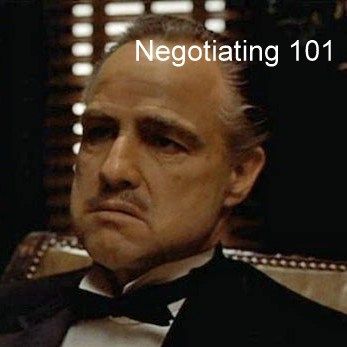 |
Real estate negotiations:
Make them an offer they can't refuse. |
Your listing agent calls and says the words that make your heart beat faster. "We have an offer."
Knowing how to respond to an offer to purchase your home makes a difference. In dollars.
To quote the Turbo Tax software, "We want to make sure you get all the money that's coming to you."
It's interesting, at least to me, that plenty of guidance is available online, in the media, and in books about buying smart.
But about
selling smart, not so much. Let's balance that scale a bit, right here and now.
Here are my tips based on what I have learned from buying and selling homes, and on what I have learned from others, and from my studies.
Always counter
Opening offers are just that. Most buyers expect they will have to increase their initial figure. To not come back with your offer -- any offer -- makes you a greedy bad guy. You never know where the talks will wind up if you don't counter.
If you accept an offer without discussing other figures or contingencies, your buyers will always wonder how low they could have gone and walked away with your property. A prime principle of successful negotiating is that when it's over, all parties feel they got what they wanted.
In fact, the more times initialed papers go back and forth, the more committed emotionally the buyer is to having the deal go through. It doesn't take long for buyers to begin planning on where they will set up their big plasma screen, and how many people they will invite to their housewarming party, even though the negotiating ball is still in the air. Keep the ball in the air.
I wrote
here about how staging helped us to not act too quickly when we received an opening, low offer on the condo we sold last year.
Know your bottom line
Have you done your homework? You should know how much it costs each month you stay in your home and maintain it.
Know the realistic value of your home in today's market, not based on what you paid for it, what you have to get to pay off credit cards, or how much you love your home.
Spring for an appraisal. The bank won't loan Mr. Buyer any more than appraised value. Note: A real estate broker's market analysis is not as accurate as a full-fledged appraisal and holds no weight with banks. Having a recent, professional appraisal is a powerful tool to have in your hands.
Your bottom line will be influenced by deadlines in your life. Your Realtor will be able to give you typical days on market figures for comparable properties in your locale. If you need or want to relocate fast, your price can reflect that.
Have backup options
It's not fun to think about, but it will strengthen your position during negotiations to have some plans in case you are on the market longer than you like. Patience is an asset when it comes to dealing. Not only do you not want to
feel desperate, you don't want the buyer to
think you are desperate.
If your carrying costs are really high, you may choose to vacate your prettily staged home and become a renter in a smaller, more economical place. Some creative sellers live in an RV, or with relatives until they get a price they like. It's just temporary.
Staging your home helps convey the message to buyers that you are comfortable and not ready to accept whatever comes along. Don't have piles of packed boxes in the garage, shed, or guest room. Get them off-site, even if it means your dad's garage.
Be the mystery seller
The more a buyer knows about you, the more leverage he has. This is especially true if you are near foreclosure or bankruptcy, if one spouse has already relocated, if you are selling an inherited property, if you are a professional house flipper, or if you have not had any offers.
At the same time, it's just smart negotiating to learn as much as you can about the prospective buyer. If he is relocating from a state where property values are high, your place may seem like a bargain, and you can anticipate an easier road to an agreed-upon price. If he has been house hunting for two years, he is either very choosy or not a serious buyer, and you can let the drama just play out without getting yourself in knots. If he is a professional rehabber, he'll be giving you bottom-feeder prices. If he is shopping for a second home, money is probably not as big a problem as with a young, first-time home buyer, and you shouldn't have to compromise.
If you are an FSBO seller, the rules change, and sitting face-to-face with a buyer calls for a different set of tactics. I'll blog about negotiating as an FSBO at another time.
 |
In her first movie, The Group, Candice Bergman (right) plays a mysterious woman
who turns out to be the strongest character in the dynamic plot. |
Fiddle with contingencies
Be imaginative. You can say, "I won't come down another $20,000, but I will leave the piano for you,"(the one you didn't want to move anyway). Let them keep some of your staging furniture. Throw in the patio furniture and the riding mower.
If you can't give in on the big things -- the money -- negotiate minor points. Delay the closing to meet their schedule, or move the closing up to make them happy. This tactic makes buyers feel like they are getting things for nothing.
Offering to pay the buyer's closing costs doesn't sound like a big deal, but it is. Most buyers are stretched and need to finance most of their purchase. If they don't have to roll in the closing costs to their mortgage, it means more to them than the actual closing costs amount. You have saved them a boatload of interest money.
Offer to finance part of their down payment for them if you can. You'll make money instead of the banks making it. A lawyer can draft the paperwork.
All these things indicate that you want the deal to go through. The buyer feels like you are on his side rather than fighting him.
 |
In their roles in Pretty Woman, Julia Roberts and Richard Gere come to an agreement about their relationship by
discussing contingencies, but each maintains his or her own sense of integrity. |
Build a relationship on integrity
Always take the high road. The usual vibe of real estate negotiating is adversarial. Buyers and sellers always assume it is a competition. That's wrong.
Assume the best of your buyer, and behave in a way that shows you are willing to work with him. Working with a Realtor, especially an experienced, hard-nosed negotiator (not necessarily Ms Nice Gal), will assure that you are not taken advantage of. In an FSBO transaction, it's even more important for buyers and sellers to trust each other.
One false step and you've destroyed credibility and trust. Examples of missteps might be: speaking negatively to your listing agent about the buyer, withholding facts about the condition of your property, or attempting to skirt the laws or ethics of real estate sales.
One of the earliest homes Mr. Lucky and I bought we bought from a man who, when he arrived at the closing, asked the lawyer to transfer the money to his brother rather than himself. He was either avoiding taxes or avoiding having to pay his estranged wife her share. The lawyer closed his book and said, "Come back when you want to do this right." It made the seller look like a snake in the grass, didn't endear him to us, and clued us to be extra vigilant in the deal.
Get outside support
Whenever negotiating seems to be deadlocked, refer to a third party. It's like referring to the umpire or referee to make a call. A third party can justify your position with facts and figures. An impartial third party can diffuse an emotional situation or clear up a deadlock.
Take your lessons from the Big Boys. International peace talks and labor union disputes are usually conducted with help from an arbitrator. If you are FSBO, you can pay a real estate agent to represent you.
Your third party could be a home inspector or an appraiser. Or it could be paperwork that substantiates your position, like documentation for things like repairs or warranties. Specifics like tax statements, electric bills, and co-op or homeowner association records, can build your case for why you are firm on your last offer.
Let Realtors be buffers
But let your own Realtor convey the image of you as a regular guy, not a fast-talking wheeler-dealer. Take your time considering the offers. A written offer usually has a 24-hour shelf life, meaning you must respond or the offer becomes void. People like to do business with people who are like them, and likable, so give all offers the courteous attention and time they deserve.
Your Realtor is here to run interference for you and keep the business of negotiating businesslike, not personal. She will shield you from giving away too much information about your position, and too much money. A good Realtor will offer constructive advice on how to proceed.
 |
Tom Cruise and his team of military lawyers pursued a vigorous defense for the men
they represented in court, in A Few Good Men. You want a realtor with that kind of tenacity. |
Be flexible
Don't walk away over a small difference. Keep the big picture in mind. If you and your prospective buyer are just 2% of your asking price apart, examine how much it could cost you to reject the offer. Review your negotiating options. Or, stick to your price, but ask them for additional favors or contingencies.
At the same time, know when to hold. We once signed with a Realtor to sell a house, and had an offer as soon as a neighbor told some friends about it, even before the MLS listing went live. We settled on a price just a token amount below our asking price because the house was so new to the market and we knew there would be other interested buyers.
Sometimes holding to a predetermined price point lets buyers know you're in a strong position. It all depends on how motivated you are to sell fast.
Follow your Realtor's advice. You're paying her for it. Real estate brokers are working for both parties and they want to see a deal happen, so they will continue to negotiate until it's obvious nothing is going to happen, or else there is agreement, and a sale!
Get the look, get the book
Do you need staging suggestions to make your home irresistible? A staged home sells faster and for more money, so there's less chance that buyers will try to grind away at your selling price. My
eBook, DIY Home Staging Tips to Sell Your Home Fast and For Top Dollar, helps you do all the right things to attract buyers
and keep them interested. You can go to my eBook page and download your copy now.































